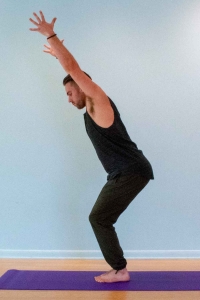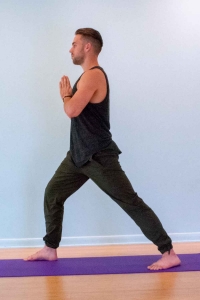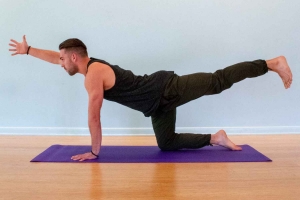The Draw-In Maneuver
By AYC Instructor Forrest Campbell
In any given yoga class you may have heard the phrase, “draw the belly in toward the spine,” or at least something similar. This fundamental and common cue has been used by many yoga and fitness professionals across the board to communicate something that has great value to spinal and abdominal organ health. Unfortunately, at times fundamentals can be pushed aside during class, so unless you are in a workshop or working one-on-one with an instructor, you may not get a thorough explanation of what the draw-in maneuver accomplishes for you.
Anatomical Overview
Our core is considered most of our torso and essentially our center of gravity. More specifically it is made up of the lumbo-pelvic-hip complex. This complex includes the lumbar spine, pelvic girdle, abdomen, and the hip joint. Our abdomen — especially the transversus abdominis— and a little bit of the pelvic floor are the focus during the draw-in maneuver.
The draw-in maneuver is the activation of the deepest layer of abdominal tissue called the transversus abdominis. This muscle is made of horizontal fibers and runs between the rib cage and the pelvis. When activated properly, the muscle fibers contract and your belly draws in, recruiting the transversus abdominis and pelvic floor. This action also compresses all the abdominal contents, which helps support the organs and lumbar spine.
How to Build Strength:
Imagine yourself squeezing and buttoning up the tightest pants in the universe. That’s the maneuver I’m talking about. Building strength and awareness in this area can take time, so patience is key. The more you practice, the more endurance and strength you build.
Tip #1
Begin by drawing the belly in and contracting. Hold for short intervals to build a neural drive, which creates a stronger contractile signal to that area from your nervous system. Do not completely cut off your breath. You can breathe while engaged, but your breath may not be as deep as normal.
Tip #2
After you become more developed and aware of the drawing-in method, you can apply this to your practice. Especially before you initiate movement or hold a posture.
You can practice this in many ways, but below are a few postures where you can build some deep abdominal strength and awareness.
Chair Utkatasana
Chair is a symmetrical posture that can be ideal for practicing the draw-in maneuver. From standing (mountain pose) bend the knees to allow the knees to project over the feet. The torso will hinge from the hips and lean slightly over thighs. In this variation to practice the draw-in maneuver, allow your cervical spine to stay in a neutral position. Draw the belly in and maintain contraction for 3-5 breaths. You may start with hands at heart center or arms extended.
Warrior 1 Virabhadrasana I
Warrior 1 is a great pose to practice drawing in the abdomen in an asymmetrical posture. For this variation, step your feet about 31/2 to 4 feet apart. Back foot can be at a 45-degree angle with the toes pointing to the outer edge of your mat. Front knee is bent. Hands can be at heart center or extending overhead. As you stand with spine long and neutral, draw the belly in towards the spine. Even though you are contracting abdominal muscles, do your best to have a steady breath. Hold here for 3-5 breaths with a focus on staying contained in the core. Repeat on the other side.
Spinal balance
Once you have achieved some strength and awareness with drawing the belly in with a neutral spine, you can take it a little farther. To begin this spinal balance posture, start on all fours in table. Extend your left leg back and allow it to be parallel to the floor. Extend right arm, parallel to the floor. Keep head and spine neutral at the start and draw the belly in. Once you feel strong and stable you can now take this into more of a backbend by lifting your arm and leg a little higher and gaze up to where the fingers are pointing. Maintain posture for 3-5 steady breaths. Repeat on the other side.
Keep Practicing
This practice can lower your chances of experiencing low back pain during yoga by strengthening the supporting muscles around the spine. It can also prepare you for more advanced abdominal movements such as Uddyana bandha, nauli kriya, and Agni Sara. Just like everything else, moderation is key. You do not want to draw your stomach in all day long, because that can overwork your muscles to the point where they become less elastic, which can subsequently limit your movement of breath. Our breath is one of the most important and fundamental aspects of our being, and we definitely do not want to bind that up.
We are all doing our best to become the strongest we can, and you can use this as one of your tools to do just that!



